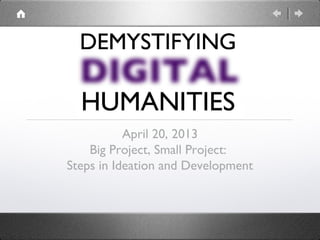Dmdh workshop 5 slides
- 1. April 20, 2013 Big Project, Small Project: Steps in Ideation and Development
- 2. Multimodal Scholarship: scholarship that takes place in more than one medium (mode), and addresses subjects which it argues cannot be accurately conveyed in a single mode.
- 3. Digital Humanities: (strenuously resists being defined!) (see slides from Workshop #1) Alt. def.: using computers to do things which would be difficult for scholars to do, which allows scholars to do things that computers canŌĆÖt do. "If We (Profs) Can Be Replaced by a Computer Screen, We Should Be!ŌĆØ --Cathy Davidson
- 4. One perspective: Digital Humanities: using digital tools to produce scholarship Multimodal scholarship: using tools to display and disseminate traditional scholarship
- 5. What is the difference between digital humanities and multimodal scholarship? (ŌĆ£produceŌĆØ vs. ŌĆ£display and disseminateŌĆØ?)
- 6. Why does the distinction between digital humanities and multimodal scholarship matter?
- 7. ŌĆó Individuals and bodies whom you encounter or work with may have opposing perspectives on the definitions. ŌĆó Whether you present your project as DH or as multimodal scholarship may be significant in terms of funding. ŌĆó You may want to adapt a fluid self- presentation that allows you to cast yourself as either, depending on the context.
- 8. How does your understanding of your work differ from the way that others understand it?
- 9. What do you work with?
- 10. What are the components of the objects you work with? ŌĆó Book: words, pages, author(s), editor(s), publisher(s), reader(s), physical edition(s), digital editions, reader responses ŌĆó Performance: sound/video file, performer, venue, date/time, program
- 11. What could a digital project be?
- 12. Ultimately, you define what form your project takes.
- 13. Components of digital/multimodal projects ŌĆó an objective (a goal or a question) ŌĆó data ŌĆó audience ŌĆó platform ŌĆó labor ŌĆó training ŌĆó schedule/timeline ŌĆó benefit (for you? for others?) ŌĆó concrete outcome
- 14. ŌĆ£Developing research ideas is more about communication than creativity.ŌĆØ --DevDH.org
- 15. Ideation Questions (Round One): Starting Out
- 16. How else might I find a project? Almost anything you care about can become a project, if you commit to it.
- 17. Ideation Questions (Round Two): Due Diligence ŌĆó Are there any existing projects that do anything similar to what you want to do? ŌĆó What is the legal status of the material that you work with? ŌĆó What kind of access do you have to these materials? ŌĆó What would be the smallest version of this project possible? (i.e., proof of concept)
- 18. Ideation Questions (Round Three): What will it take to make this happen? ŌĆó What skills are involved? ŌĆó What are my real strengths, and where might it be better to collaborate with others? ŌĆó Who will you need to work with? ŌĆó How long do you anticipate this project lasting?
- 19. Ideation Questions (Round Four): Publishing your practice ŌĆó Could you produce your project in a more traditional format for your discipline? (e.g., an essay?) How would your project provide different coverage than a traditional argument? ŌĆó How does your planned project intersect with what other people are doing? ŌĆó How can I share my process? To what extent and for what reasons do I want to do so? ŌĆó What makes this a DH -- or multimodal -- project?
- 20. The life of your project is in the way that (other) people use it.
- 22. In digital humanities, you may need to build your audience before you build your project.
- 23. GRADUATE STUDENT LABOR The scope of graduate student labor is ill- defined. You will need to define what is required, and articulate that to others.
- 24. How does my project fit into my graduate program?
- 25. Balancing a DH project with a graduate degree program ŌĆó Consider how and whether you want to position your project within the boundaries dictated by your program and its degree requirements.
- 26. Balancing a DH project with a graduate degree program ŌĆóIdentify the people who are overseeing and evaluating the work you do on your project. ŌĆóMeet with those people to discuss the practical aspects of your projectŌĆÖs running and marketing. (adapted from Amanda ViscontiŌĆÖs ŌĆ£Five Tips For Getting Started On A Digital Humanities DissertationŌĆØ)
- 28. Project management ŌĆó creating and maintaining a schedule ŌĆó knowing your own skills ŌĆó being aware of and making use of resources ŌĆó having a realistic conception of all of the above.
- 29. Scheduling tips ŌĆó Develop granular goals. ŌĆó Make your schedule for increments of time that work for you. ŌĆó Assess how well the schedule is working, and adapt it as needed.
- 30. Know yourself ŌĆó What types of work do you have the most energy/patience for? ŌĆó What types of work do you find frustrating? ŌĆó What aspects of collaboration do you embrace? What aspects do you struggle with? BE HONEST ABOUT YOUR ABILITIES.
- 31. Investigate available resources ŌĆó UW Libraries Digital Initiatives ŌĆó The Simpson Center ŌĆó UW Information Technology (UW-IT) ŌĆó Other departments
- 32. Asking is the key to developing a cohort. Your project may be more transferable than your dissertation.
- 33. Where else can I ask? ŌĆó DH Commons ŌĆó Twitter ŌĆó Local UnConferences
- 34. Be mindful of the return on investment (ROI) for each activity.
- 35. Why would you want a project, given how much work it is?
- 36. When managed mindfully, a DH project can provide a sense of agency that complements and enhances traditional academic work.
- 37. But do you have to have a project to do DH?
- 38. Stay tuned for our next workshop! Saturday, May 4, 9:30a.m.-1:00p.m. Available Tools: Free, Cheap, and Premium ŌĆó PivotalTracker ŌĆó Scalar ŌĆó ManyEyes ŌĆó Finding tools, and deciding when theyŌĆÖre worth buying. Thanks to our sponsors! UW Textual Studies Program






































